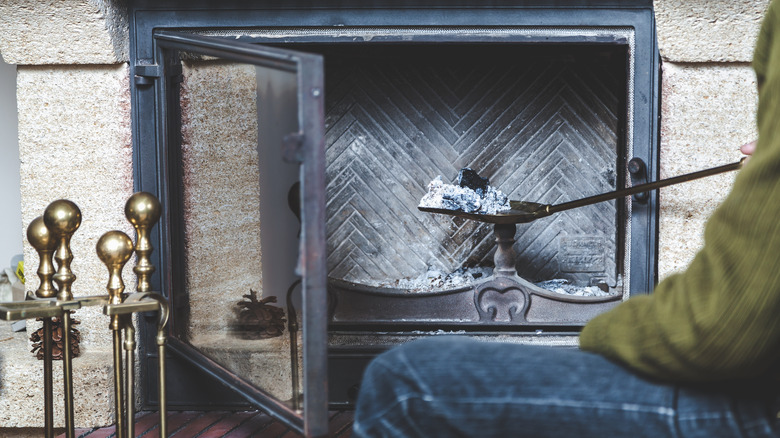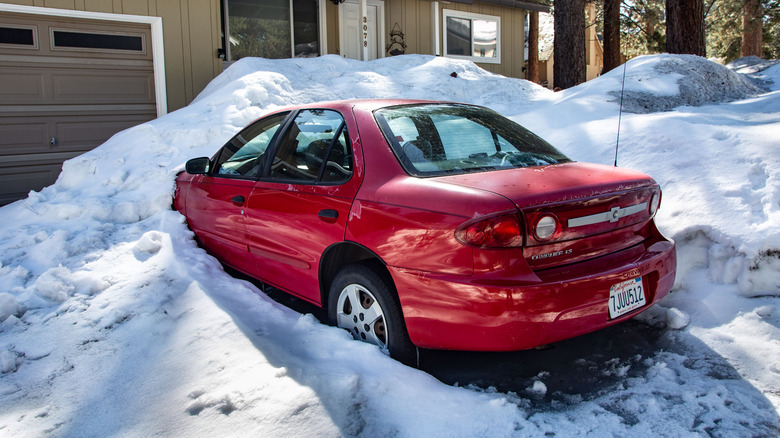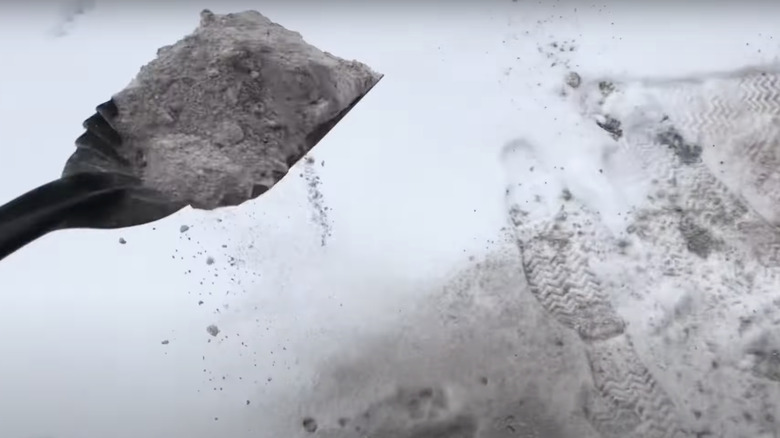Can Your Fireplace Ash Really Help Melt The Snow In Your Yard And On Your Driveway?
A snowy front lawn creates a picture-perfect moment, making you feel like you're in a snow globe, but that feeling dissipates quickly when you're trying to get to work and shoveling snow out of the driveway. We've all heard that spreading table salt creates traction, keeps you from slipping, and de-ices all surfaces, but it's not the best solution since it also damages soil, plants, and paved surfaces. Instead, fireplace ash is an excellent, eco-friendly, and budget-conscious alternative de-icer, providing purchase on every icy surface and helping snow melt.
Fireplace ash works incredibly well mainly due to its color. The black ashes on the white snow absorb more heat from the sun, causing the snow to melt faster. Surprisingly, Utah and Pocatello Valley farmers have used fireplace ash for the last three decades to melt snow, after Utah State University researched and approved the method. According to the Idaho State Journal, one farmer, Syd Fuhriman, has spread ash over his 3,000-acre wheat farm since the 1980s, stating, "You can't believe how fast [the snow] will melt."
Fireplace ash won't harm your plants or cars
Many of the de-icers you're used to, such as table salt, calcium chloride, and potassium chloride, will help melt snow and provide traction. Still, they'll harm your plants, corrode metals and concrete, and leave a slippery residue when they wash away or melt. Spreading ash over your snow-covered yard and driveway will actually benefit your plants, since it contains over a dozen nutrients, including magnesium, calcium, and potassium, that support a plant's growth. Also, spreading ash will prepare your lawn in the winter to get it lush for the spring. Stick to ash from hardwood since it burns longer, will leave you with more ash and is filled with more nutrients than softwood. Plus, when you burn it, you don't have to worry about too much smoke from the wood filling every room.
Fireplace ash also won't damage concrete or metals like other de-icers. Salt, for example, makes metals rust when mixed with water, affecting your car. While it gives your tires excellent traction, you could end up with a rusty car over time. Even if it doesn't rust your car, salt can seep into the concrete of your driveway or sidewalk, mixing with the chemicals in the concrete to cause internal cracks and damage the structure. Fireplace ash, meanwhile, is entirely water-soluble, so it'll simply wash away when it gets wet.
Types of ash to use and safety precautions to consider
There are a few things to be cautious of when using fireplace ash to melt snow. It's vital to use the right kind of ash to ensure optimal results. Avoid using ash from a grill or fire pit because it contains chemicals from starter fluid that are harmful to your plants and lawn; instead, stick to firewood ash. Don't use cardboard, painted wood, or pressure-treated wood, because they also carry harsh chemicals that will harm your lawn and gardens. Oak, maple, sycamore, walnut, and other hardwoods are all excellent options when gathering ash for your snowy driveway and lawn.
There are also safety precautions to consider when handling ash. For instance, always allow the ashes to dry completely for 24 hours. When removing ashes from your fireplace, wear gloves to protect your hands from their alkaline content. Wear protective goggles or even a face mask; you don't want to inhale finer ash particles or accidentally rub your eyes with ash residue on your gloved fingers. Place the ash in a metal container instead of cardboard or a plastic bag to prevent any from lighting up inside. Once you collect the ashes, use a shovel to disperse them over your lawn and driveway. Since the ash will be spread where you walk, keep in mind that — like the snow it's clearing away — it can get tracked into the house.


